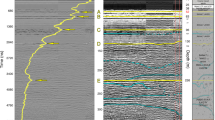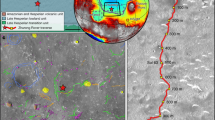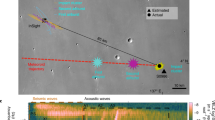Abstract
A hemispheric dichotomy on Mars is marked by the sharp contrast between the sparsely cratered northern lowland plains and the heavily cratered southern highlands. Mechanisms proposed to remove ancient crust or form younger lowland crust include one or more giant impacts, subcrustal transport by mantle convection, the generation of thinner crust by plate tectonics, and mantle overturn following solidification of an early magma ocean1,2,3,4,5,6,7. The age of the northern lowland crust is a significant constraint on these models. The Mars Advanced Radar for Subsurface and Ionospheric Sounding (MARSIS) instrument on the European Space Agency’s Mars Express spacecraft is providing new constraints on the martian subsurface8. Here we show evidence of buried impact basins ranging in diameter from about 130 km to 470 km found over ∼14 per cent of the northern lowlands. The number of detected buried basins >200 km in diameter indicates that the lowland crust is ancient, dating back to the Early Noachian epoch. This crater density is a lower limit because of the likelihood that not all buried basins in the area surveyed by MARSIS have been detected. An Early Noachian age for the lowland crust has been previously suggested on the basis of a large number of quasi-circular topographic depressions interpreted to be evidence of buried basins9,10,11. Only a few of these depressions in the area surveyed by MARSIS, however, correlate with the detected subsurface echoes. On the basis of the MARSIS data, we conclude that the northern lowland crust is at least as old as the oldest exposed highland crust. This suggests that the crustal dichotomy formed early in the geologic evolution of Mars.
This is a preview of subscription content, access via your institution
Access options
Subscribe to this journal
Receive 51 print issues and online access
$199.00 per year
only $3.90 per issue
Buy this article
- Purchase on Springer Link
- Instant access to full article PDF
Prices may be subject to local taxes which are calculated during checkout




Similar content being viewed by others
References
Wilhelms, D. E. & Squyres, S. W. The martian hemispheric dichotomy may be due to a giant impact. Nature 309, 138–140 (1984)
McGill, G. E. Buried topography of Utopia, Mars: Persistence of a giant impact depression. J. Geophys. Res. 94, 2753–2759 (1989)
Frey, H. & Schultz, R. A. Large impact basins and the mega-impact origin for the crustal dichotomy on Mars. Geophys. Res. Lett. 15, 229–232 (1988)
Wise, D. U., Golombek, M. P. & McGill, G. E. Tharsis province of Mars: Geologic sequence, geometry and a deformation mechanism. Icarus 38, 456–472 (1979)
McGill, G. E. & Dimitriou, A. M. Origin of the martian global dichotomy by crustal thinning in the late Noachian or early Hesperian. J. Geophys. Res. 95, 12595–12605 (1990)
Sleep, N. H. Martian plate tectonics. J. Geophys. Res. 99, 5639–5656 (1994)
Elkins-Tanton, L. T., Parmentier, E. M. & Hess, P. C. The formation of ancient crust on Mars through magma ocean processes. J. Geophys. Res. 110 E12S01 doi: 10.1029/2005JE002480 (2005)
Picardi, G. et al. Radar soundings of the subsurface of Mars. Science 310, 1925–1928 (2005)
Frey, H. V., Roark, J. H., Shockey, K. M., Frey, E. L. & Sakimoto, S. E. H. Ancient lowlands on Mars. Geophys. Res. Lett. 29 doi: 10.1029/2001GL013832 (2002)
Frey, H. V. Impact constraints on the age of origin of the lowlands of Mars. Geophys. Res. Lett. 33 doi: 10.1029/2005GL024484 (2006)
Frey, H. V. Impact constraints on, and a chronology for, major events in early Mars history. J. Geophys. Res. 111 doi: 10.1029/2005JE002449 (2006)
Scott, D. H. & Tanaka, K. L. Geologic map of the western equatorial region of Mars, scale 1:15,000,000. US Geol. Surv. Misc. Invest. Ser. Map I-1802-A, (1986)
Greeley, R. & Guest, J. E. Geologic map of the eastern equatorial region of Mars, scale 1:15,000,000. US Geol. Surv. Misc. Invest. Ser. Map I-1802-B, (1987)
Tanaka, K. L. & Scott, D. H. Geologic maps of the polar regions of Mars, scale 1:15,000,000. US Geol. Surv. Misc. Invest. Ser. Map. I-1802-C, (1987)
Solomon, S. C. et al. New perspectives on ancient Mars. Science 307, 1214–1220 (2005)
Lenardic, A., Nimmo, F. & Moresi, L. Growth of the hemispheric dichotomy and the cessation of plate tectonics on Mars. J. Geophys. Res. 109 E02003 doi: 10.1029/2003JE002172 (2004)
Zhong, S. & Zuber, M. T. Degree-1 mantle convection and the crustal dichotomy on Mars. Earth Planet. Sci. Lett. 189, 75–84 (2001)
Roberts, J. H. & Zhong, S. Degree-1 convection in the Martian mantle and the origin of the hemispheric dichotomy. J. Geophys. Res. 111 doi: 10.1029/2005JE002668 (2006)
Head, J. W., Kreslavsky, M. A. & Pratt, S. Northern lowlands of Mars: Evidence for widespread volcanic flooding and tectonic deformation in the Hesperian Period. J. Geophys. Res. 107 doi: 10.1029/2000JE001445 (2002)
Zuber, M. T. The crust and mantle of Mars. Nature 412, 220–227 (2001)
Tanaka, K. L. et al. Resurfacing history of the northern plains of Mars based on geologic mapping of Mars Global Surveyor data. J. Geophys. Res. 108 (E4)doi: 10.1029/2002JE001908 (2003)
Tanaka, K. L. et al. Geologic map of the northern plains of Mars. US Geol. Surv. Misc. Invest. Ser. Map I-2888, (2005)
Kreslavsky, M. A. & Head, J. W. The fate of outflow channel effluents in the northern lowlands of Mars: The Vastitas Borealis Formation as a sublimation residue from frozen ponded bodies of water. J. Geophys. Res. 107 (E12)5121 doi: 10.1029/2001JE001831 (2002)
Mustard, J. F. et al. Olivine and pyroxene diversity in the crust of Mars. Science 307, 1594–1597 (2005)
Melosh, H. J. Impact Cratering: A Geologic Process (Oxford Univ. Press, New York, 1989)
Tanaka, K. L. The stratigraphy of Mars. J. Geophys. Res. 91, E139–E158 (1986)
Acknowledgements
We thank J. W. Head and D. D. Blankenship for constructive criticism and advice that greatly improved the paper. We also thank H. V. Frey for providing the locations and diameters of the QCDs. We are grateful to the other members of the MARSIS Science team and to the instrument operation staff. MARSIS is managed by the Agenzia Spaziale Italiana (ASI) and the National Aeronautics and Space Administration (NASA). The Mars Express mission is managed and operated by the European Space Agency. The research activities of the MARSIS PI and Italian investigators were supported by the Mars Express/ASI programme; the work of the US investigators was supported by the Mars Express/NASA project.
Author information
Authors and Affiliations
Corresponding author
Ethics declarations
Competing interests
Reprints and permissions information is available at www.nature.com/reprints. The authors declare no competing financial interests.
Supplementary information
Supplementary Information
This file contains Supplementary Notes with supporting Supplementary Figures discussing MARSIS antenna and instrument operations, buried basins in Chyrse Planitia, Acidilia, Amazonia, Elyisum and Utopia Planitiea, estimate of MARSIS coverage of the northern lowlands and the Supplementary Figure S1. (PDF 764 kb)
Rights and permissions
About this article
Cite this article
Watters, T., Leuschen, C., Plaut, J. et al. MARSIS radar sounder evidence of buried basins in the northern lowlands of Mars. Nature 444, 905–908 (2006). https://doi.org/10.1038/nature05356
Received:
Accepted:
Issue Date:
DOI: https://doi.org/10.1038/nature05356
This article is cited by
-
Venus Evolution Through Time: Key Science Questions, Selected Mission Concepts and Future Investigations
Space Science Reviews (2023)
-
Remote Sensing for Martian Studies: Inferences from Syrtis Major
Journal of the Indian Society of Remote Sensing (2018)
-
The Lunar Radar Sounder (LRS) Onboard the KAGUYA (SELENE) Spacecraft
Space Science Reviews (2010)
-
Instrumentation and observation target of the Lunar Radar Sounder (LRS) experiment on-board the SELENE spacecraft
Earth, Planets and Space (2008)
Comments
By submitting a comment you agree to abide by our Terms and Community Guidelines. If you find something abusive or that does not comply with our terms or guidelines please flag it as inappropriate.



